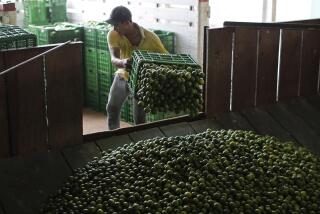Tomato Prices Put a Squeeze on Mexico
MEXICO CITY — If it were a B-movie instead of an economic threat, it might be called the Attack of the Killer Tomatoes.
But a recent Mexican government report isn’t joking about the latest menace to the economy. Damaging storms have sent tomato prices ballooning like the mutant veggies in the 1978 cult classic. The rise is crimping shoppers’ pocketbooks, stoking inflation fears and upending economic forecasts.
The Argentines have their beef, the Irish their potatoes and the Koreans their spicy cabbage, kimchi. But no dietary staple can gyrate a nation’s consumer price index like Mexico’s tomatoes.
Government economists are blaming the jitomate (pronounced EE-toe-mah-tay), as the red tomato is called here, for much of the 0.6% rise in the consumer price index in the first half of September. That’s double the increase in the first two weeks of August and much higher than analysts’ forecasts.
“I can’t recall another country where one food item seems to be so important” in determining inflation, said Gray Newman, head of Latin America research at Morgan Stanley in New York.
Shopping for produce at the sprawling Central de Abastos market in the southeastern part of the capital this week, homemaker Virginia Meneses was stunned by tomato prices that have tripled to as much as $1 a pound for some varieties. Small stores are charging even more.
A buck looks downright cheap compared with the nearly $4 a pound that some California consumers are paying now for premium tomatoes. Still, it’s a hefty sum in Mexico, where many people earn the minimum wage of about $4.30 a day.
A meal without some tomatoes mixed into a soup, salsa or salad wouldn’t pass muster with her family, said Meneses, a 39-year-old mother of three. She reluctantly bought $9 worth, forking over nearly a third of her weekly produce budget.
“How awful!” she said. “I’ll just have to buy less fruit.”
Meneses isn’t the only one making adjustments. The red scare has so rattled Mexico’s central bank that it now projects that 2006 inflation could soar as high as 4%, up substantially from last year’s 3.3%, the lowest level in 30 years.
That’s making inflation hawks at the institution worry that hard-won gains might be undone by a garden vegetable. And it is likely to complicate their decision as to what to do about interest rates in the weeks ahead.
Mexico’s economy is growing at a healthy clip for the first time in years. Lower interest rates would help sustain an expansion that could be weakened by a slowdown in the U.S. economy. But a rate cut could add to inflation pressures.
Although some analysts said the jitomate-led jump in consumer prices is temporary and that Mexico’s core inflation remains in check, they said it was a reminder that a diminutive vegetable has an outsize effect on consumer prices here.
The Aztecs were cultivating tomatoes in what is now Mexico when the Spanish conquerors arrived in the early 16th century. The seeds were whisked to Europe. In a short time, vines produced a vegetable that became an essential part of French, Spanish and Italian cuisine.
In Mexico, tomatoes are never far from the table. They are served over eggs in huevos rancheros, simmered in the rich broth of tortilla soup and chopped up in the ubiquitous spicy condiment known as pico de gallo.
The nation produced about 2.2 million tons last year, about 902,000 tons of which were exported, mostly to the United States, according to Mexico’s ministry of agriculture. But domestic consumption remains strong.
“If we have three meals a day we have tomatoes three times a day,” said Mexican-born Alfredo Coutino, senior economist at Moody’s Economy.com in West Chester, Pa. He said the inflation link “is uniquely Mexican.”
How a salad ingredient could send jitters through one of Latin America’s largest economies is one of the odder convergences of culture and the dismal science.
Similar to citizens of other developing countries, Mexicans spend a larger share of their incomes on food than people in wealthier nations. Food items account for nearly one-quarter of the fixed basket of consumer goods and services that the Mexican government tracks to keep tabs on inflation, according to analyst Newman. So that explains why staples like tomatoes carry more weight in Mexico than they do in a country like the United States, he said.
Mexico’s multiple climate zones allow people here to eat the solanaceous vegetable year-round. But like all fresh produce, tomatoes are more subject to price changes than foods such as flour and dried beans that can be stored longer. Tomatoes can be particularly vulnerable because most Mexican farmers don’t irrigate their crops, relying on whatever rains come their way.
In mid-September, Hurricane Lane slammed the western state of Sinaloa, Mexico’s No. 1 tomato-producing state, damaging thousands of acres. Earlier that month, Hurricane John pummeled Baja California Sur, another prime growing spot. In previous years, drought has been the culprit rather than wind and rain.
Thus big price swings in jitomates are commonplace. Newman said the current run-up was the fourth in the last two years alone. The analyst calculates that prices are up an average of 131% compared with July levels but could normalize within a few months.
But that’s small comfort to Maria Gamboa, 62.
With tomato prices skyrocketing, the Mexico City resident has had to cut her consumption in half, scrimping on the ingredient in every dish she makes.
“It doesn’t taste the same,” she said. “But a little is better than nothing.”
*
*
Times staff writer Cecilia Sanchez contributed to this report.
More to Read
Sign up for Essential California
The most important California stories and recommendations in your inbox every morning.
You may occasionally receive promotional content from the Los Angeles Times.










